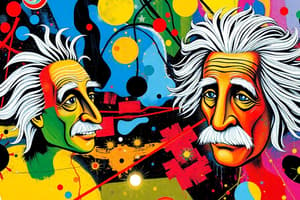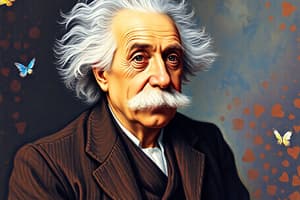Podcast
Questions and Answers
What phenomenon is described by the behavior of bosons at temperatures near absolute zero?
What phenomenon is described by the behavior of bosons at temperatures near absolute zero?
- Superconductivity (correct)
- Quantum entanglement
- Black hole formation
- Nuclear fusion
What concept did Einstein develop to include the effects of gravity in his theory?
What concept did Einstein develop to include the effects of gravity in his theory?
- Newtonian mechanics
- Quantum field theory
- General relativity (correct)
- Inertial frames of reference
Which principle relates to the observation that clocks moving relative to each other tick at different rates?
Which principle relates to the observation that clocks moving relative to each other tick at different rates?
- Time dilation (correct)
- Lorentz contraction
- Conservation of energy
- Mass-energy equivalence
What was Albert Einstein's primary conclusion about the relationship between space and time?
What was Albert Einstein's primary conclusion about the relationship between space and time?
In the context of light's speed, what does Einstein assert regarding an observer's movement relative to the light's source?
In the context of light's speed, what does Einstein assert regarding an observer's movement relative to the light's source?
What was the primary focus of Nettie Stevens's research?
What was the primary focus of Nettie Stevens's research?
Which of the following statements best describes the scientific community's view on sex determination before Stevens's findings?
Which of the following statements best describes the scientific community's view on sex determination before Stevens's findings?
What notable educational achievement did Nettie Stevens accomplish first?
What notable educational achievement did Nettie Stevens accomplish first?
Despite her significant contributions, how was Nettie Stevens's work received during her lifetime?
Despite her significant contributions, how was Nettie Stevens's work received during her lifetime?
What specific chromosomes were identified by Nettie Stevens as responsible for determining sex?
What specific chromosomes were identified by Nettie Stevens as responsible for determining sex?
In what year did Nettie Stevens publish her findings on sex determination?
In what year did Nettie Stevens publish her findings on sex determination?
Who supervised Nettie Stevens during her PhD studies?
Who supervised Nettie Stevens during her PhD studies?
Who was the first to discover natural radioactivity?
Who was the first to discover natural radioactivity?
In what year did Marie Curie isolate pure radium?
In what year did Marie Curie isolate pure radium?
What was Henri Becquerel investigating when he discovered radioactivity?
What was Henri Becquerel investigating when he discovered radioactivity?
Which Nobel Prize did Marie Curie win for her work on radium?
Which Nobel Prize did Marie Curie win for her work on radium?
What is the unit of radioactivity named after?
What is the unit of radioactivity named after?
What did Curie fail to recognize about radioactive substances?
What did Curie fail to recognize about radioactive substances?
What phenomenon was Becquerel primarily interested in before discovering radioactivity?
What phenomenon was Becquerel primarily interested in before discovering radioactivity?
What did Curie do with radioactive samples in terms of storage?
What did Curie do with radioactive samples in terms of storage?
What was a significant outcome of Becquerel's experiment with uranium salt?
What was a significant outcome of Becquerel's experiment with uranium salt?
What did Rutherford discover about alpha radiation in 1899?
What did Rutherford discover about alpha radiation in 1899?
What was the outcome of Rutherford's research at McGill University?
What was the outcome of Rutherford's research at McGill University?
What significant event in atomic theory did Rutherford contribute to in 1911?
What significant event in atomic theory did Rutherford contribute to in 1911?
What recognition did Rutherford receive for his research in 1908?
What recognition did Rutherford receive for his research in 1908?
How did Rutherford's experiments change the understanding of atomic structure?
How did Rutherford's experiments change the understanding of atomic structure?
What unique process did Rutherford achieve by colliding alpha particles with nitrogen in 1919?
What unique process did Rutherford achieve by colliding alpha particles with nitrogen in 1919?
What was the primary innovation proposed by Rutherford regarding radioactivity?
What was the primary innovation proposed by Rutherford regarding radioactivity?
Which physicist recommended Rutherford for a professorship at McGill University?
Which physicist recommended Rutherford for a professorship at McGill University?
What aspect of Rutherford's research was he surprised to be recognized for?
What aspect of Rutherford's research was he surprised to be recognized for?
How did Rutherford's findings on the behavior of alpha particles contribute to atomic theory?
How did Rutherford's findings on the behavior of alpha particles contribute to atomic theory?
What was Moniz's primary motivation for developing vascular imaging?
What was Moniz's primary motivation for developing vascular imaging?
Which substance did Moniz find to provide the safest and clearest results in his vascular imaging experiments?
Which substance did Moniz find to provide the safest and clearest results in his vascular imaging experiments?
What was the main reason Moniz's lobotomy technique faced criticism?
What was the main reason Moniz's lobotomy technique faced criticism?
What did Moniz invent to aid in the lobotomy procedure?
What did Moniz invent to aid in the lobotomy procedure?
In what year was Moniz's first paper on angiography published?
In what year was Moniz's first paper on angiography published?
What significant change in diagnostic imaging occurred in 1975?
What significant change in diagnostic imaging occurred in 1975?
Flashcards
Sex Determination by Chromosomes
Sex Determination by Chromosomes
Stevens made the groundbreaking discovery in the early 20th century that the sex of an animal is determined by specific chromosomes, specifically the X and Y chromosomes.
Stevens' Mealworm Study
Stevens' Mealworm Study
Stevens conducted her research on mealworms, observing their chromosome behavior. This allowed her to connect the physical characteristic of sex to a specific chromosome.
Stevens' Education
Stevens' Education
Stevens graduated from Stanford University with a Master's in Biology in 1900, then pursued her doctorate at Bryn Mawr College, earning it in 1903.
Stevens' Recognition
Stevens' Recognition
Signup and view all the flashcards
Prevailing Theories on Sex Determination
Prevailing Theories on Sex Determination
Signup and view all the flashcards
Stevens' Discovery Publication
Stevens' Discovery Publication
Signup and view all the flashcards
Stevens' Impact on Genetics
Stevens' Impact on Genetics
Signup and view all the flashcards
Rutherford Model of the Atom
Rutherford Model of the Atom
Signup and view all the flashcards
Alpha Radiation
Alpha Radiation
Signup and view all the flashcards
Beta Radiation
Beta Radiation
Signup and view all the flashcards
Radioactive Decay
Radioactive Decay
Signup and view all the flashcards
Transmutation of Elements
Transmutation of Elements
Signup and view all the flashcards
Proton
Proton
Signup and view all the flashcards
Nuclear Fission
Nuclear Fission
Signup and view all the flashcards
Atomic Structure
Atomic Structure
Signup and view all the flashcards
Radioactivity
Radioactivity
Signup and view all the flashcards
Discovery of Radioactivity
Discovery of Radioactivity
Signup and view all the flashcards
Who discovered natural radioactivity?
Who discovered natural radioactivity?
Signup and view all the flashcards
Who was Marie Curie?
Who was Marie Curie?
Signup and view all the flashcards
Who coined the term 'radioactivity'?
Who coined the term 'radioactivity'?
Signup and view all the flashcards
How did Marie Curie's research compare to her husband's?
How did Marie Curie's research compare to her husband's?
Signup and view all the flashcards
Why is it important to be careful with radioactive substances?
Why is it important to be careful with radioactive substances?
Signup and view all the flashcards
What is radium and how is it used?
What is radium and how is it used?
Signup and view all the flashcards
What is Marie Curie's lasting legacy?
What is Marie Curie's lasting legacy?
Signup and view all the flashcards
How did Stevens' work change the understanding of sex determination?
How did Stevens' work change the understanding of sex determination?
Signup and view all the flashcards
Bose-Einstein Condensate (BEC)
Bose-Einstein Condensate (BEC)
Signup and view all the flashcards
General Relativity
General Relativity
Signup and view all the flashcards
Spacetime Continuum
Spacetime Continuum
Signup and view all the flashcards
Constant Speed of Light
Constant Speed of Light
Signup and view all the flashcards
Time Dilation
Time Dilation
Signup and view all the flashcards
What was Moniz's technique for brain tumor identification?
What was Moniz's technique for brain tumor identification?
Signup and view all the flashcards
How long was Moniz's technique the primary tool for imaging brain vessels?
How long was Moniz's technique the primary tool for imaging brain vessels?
Signup and view all the flashcards
What was Moniz's belief about psychosurgery?
What was Moniz's belief about psychosurgery?
Signup and view all the flashcards
What instrument did Moniz design for psychosurgery?
What instrument did Moniz design for psychosurgery?
Signup and view all the flashcards
Who were the targets of Moniz's lobotomies?
Who were the targets of Moniz's lobotomies?
Signup and view all the flashcards
How widespread was Moniz's lobotomy technique?
How widespread was Moniz's lobotomy technique?
Signup and view all the flashcards
What were the outcomes of Moniz's lobotomy procedure?
What were the outcomes of Moniz's lobotomy procedure?
Signup and view all the flashcards
What unfortunate incident did Moniz experience in 1939?
What unfortunate incident did Moniz experience in 1939?
Signup and view all the flashcards
What does Moniz's continued practice after the shooting reveal about him?
What does Moniz's continued practice after the shooting reveal about him?
Signup and view all the flashcards
What prestigious award did Moniz receive?
What prestigious award did Moniz receive?
Signup and view all the flashcards
Study Notes
Scientists Who Changed History
- The book is a compilation of biographies of scientists who made significant contributions to their respective fields.
- The time frame covered is from 1895 to 1925.
Milestones
- The book details the lives and achievements of various scientists during a particular period in history.
- Key scientists are listed throughout the book.
- Their discoveries, inventions, research, and accomplishments are included in the biographies.
- The book details milestones in scientific discoveries and inventions.
- Key dates are included to showcase their major contributions to their field.
- The book shows that these scientists' work has significantly impacted multiple fields of science.
Paradigm Shifts (1895-1925)
- This section outlines major paradigm shifts in science during this era.
- Five paradigm shifts are introduced.
- The time frame of the shifts are from 1895 to 1925.
Milestones (Specific Scientists)
- Santiago Ramón y Cajal:
- A Nobel Prize-winning neuroscientist.
- Used microscopes to understand the nervous system.
- Realized the nervous system consists of independent cells that communicate.
- Improved tissue-staining techniques.
- Published works on the structure of the nervous system.
- Won the Nobel Prize in 1906 with Camillo Golgi.
- Max Planck:
- Developed quantum theory.
- Showed energy is released in discrete packets, not continuously.
- Fundamental shift in subatomic physics.
- Calculated the relationship between the energy (E) emitted by an object and its frequency.
- Won Nobel Prize in 1918
- Nettie Stevens:
- Discovered that sex is determined by chromosomes (X and Y).
- Pioneered research in genetics.
- Published her findings on sex determination in 1905.
- George Washington Carver:
- Agricultural scientist.
- Developed innovative scientific soil improvement and crop cultivation methods.
- Created over 300 commercially viable products from crops like peanuts and sweet potatoes, boosting the Southern US economy.
- Instrumental in promoting sustainable agriculture.
- Thomas Hunt Morgan:
- Geneticist and zoologist, pioneering work on heredity.
- Confirmed the role of chromosomes in inheritance, building on Mendel's work.
- Pioneered the use of fruit flies in genetic research.
- Marie Curie:
- Groundbreaking research in radioactivity.
- Discovered the elements polonium and radium.
- Invented methods to isolate radium for use in cancer treatment.
- Awarded the Nobel Prize in Physics and Chemistry (one of the very few to have won it in two different scientific fields).
- Ernest Rutherford:
- Transformed our understanding of atoms.
- Determined the structure of atoms. Explained how atoms disintegrate into smaller constituents.
- Disovered alpha and beta radioactivity.
- Antonio Egas Moniz:
- Performed pioneering research in brain imaging.
- Developed the controversial surgical procedure known as a lobotomy.
- Lise Meitner:
- Coined the term "nuclear fission." and explained the splitting of atoms.
- Aided the discovery of nuclear fission by colleagues.
- Albert Einstein:
- Developed the theories of special and general relativity. Revolutionized physics.
- Alfred Wegener:
- Proposed the theory of continental drift.
- Compiled evidence from various fields for his theory from fossils and glacial deposits.
- Sydney Brenner:
- Pioneered research in developmental biology and genetics.
- Advanced molecular biology understanding.
- Francis Crick & James Watson:
- Discovered the double helix structure of DNA.
- Breakthrough in molecular biology and genetics.
- Rosalind Franklin:
- Provided key X-ray diffraction images that were crucial for Crick and Watson's DNA model.
- Propose the "backbone" of DNA.
- Maurice Wilkins:
- Also worked on X-ray crystallography aspects of DNA structure, though Rosalind Franklin's work was crucial.
- Frederick Sanger:
- Pioneered DNA sequencing techniques, greatly advancing understanding of genes and genetic information. - Sequenced 48,502 base pairs by 1982
- Henry Stommel:
- US oceanographer.
- Explored ocean currents (Gulf Stream).
- Yang Chen-ning:
- Revolutionized particle physics with research on subatomic decay.
- Benoit Mandelbrot:
- Founded "fractal geometry”.
- Ernest McCulloch & James Till:
- Discovered stem cells.
- Tu Youyou:
- Chinese pharmacologist.
- Isolated artemisinin, a crucial antimalaria treatment.
- Patricia Bath:
- Pioneer in ophthalmology.
- An inventor and laser scientist.
- Stephen Hawking:
- Theoretical physicist.
- Expired the nature of black holes and the Universe. Propose the theory of "Everything."
- Jocelyn Bell Burnell:
- Discovered pulsars.
- Helped develop radio telescopes.
General
- The figures highlighted had significant roles in scientific breakthroughs and advancements.
- They showcase the importance of collaborative work and the integration of multiple disciplines
- The scientists' work brought about revolutionary changes in their fields and inspired other research.
Studying That Suits You
Use AI to generate personalized quizzes and flashcards to suit your learning preferences.



